Plougastel-Daoulas
| Plougastel-Daoulas | ||
|---|---|---|
|
Women of Plougastel by Charles Cottet, 1903 | ||
| ||
 Plougastel-Daoulas | ||
|
Location within Brittany region  Plougastel-Daoulas | ||
| Coordinates: 48°22′24″N 4°22′10″W / 48.3733°N 4.3694°WCoordinates: 48°22′24″N 4°22′10″W / 48.3733°N 4.3694°W | ||
| Country | France | |
| Region | Brittany | |
| Department | Finistère | |
| Arrondissement | Brest | |
| Canton | Daoulas | |
| Intercommunality | Brest Métropole Océane | |
| Government | ||
| • Mayor (2014–2020) | Dominique Cap | |
| Area1 | 46.83 km2 (18.08 sq mi) | |
| Population (2008)2 | 13,098 | |
| • Density | 280/km2 (720/sq mi) | |
| Time zone | CET (UTC+1) | |
| • Summer (DST) | CEST (UTC+2) | |
| INSEE/Postal code | 29189 / 29470 | |
| Elevation |
0–145 m (0–476 ft) (avg. 110 m or 360 ft) | |
|
1 French Land Register data, which excludes lakes, ponds, glaciers > 1 km² (0.386 sq mi or 247 acres) and river estuaries. 2 Population without double counting: residents of multiple communes (e.g., students and military personnel) only counted once. | ||
Plougastel-Daoulas (Breton: Plougastell-Daoulaz) is a commune in the Finistère department of Brittany in northwestern France.
Population
Inhabitants of Plougastel-Daoulas are called plougastels in French.
| Historical population | ||
|---|---|---|
| Year | Pop. | ±% |
| 1793 | 4,059 | — |
| 1800 | 4,059 | +0.0% |
| 1806 | 4,660 | +14.8% |
| 1821 | 5,111 | +9.7% |
| 1831 | 5,515 | +7.9% |
| 1836 | 5,863 | +6.3% |
| 1841 | 5,731 | −2.3% |
| 1846 | 5,999 | +4.7% |
| 1851 | 6,065 | +1.1% |
| 1856 | 5,970 | −1.6% |
| 1861 | 6,090 | +2.0% |
| 1866 | 6,282 | +3.2% |
| 1872 | 6,315 | +0.5% |
| 1876 | 6,506 | +3.0% |
| 1881 | 6,857 | +5.4% |
| 1886 | 7,009 | +2.2% |
| 1891 | 7,162 | +2.2% |
| 1896 | 7,655 | +6.9% |
| 1901 | 7,677 | +0.3% |
| 1906 | 7,733 | +0.7% |
| 1911 | 7,874 | +1.8% |
| 1921 | 7,065 | −10.3% |
| 1926 | 6,965 | −1.4% |
| 1931 | 6,914 | −0.7% |
| 1936 | 6,726 | −2.7% |
| 1946 | 6,894 | +2.5% |
| 1954 | 6,945 | +0.7% |
| 1962 | 6,726 | −3.2% |
| 1968 | 7,075 | +5.2% |
| 1975 | 8,138 | +15.0% |
| 1982 | 9,581 | +17.7% |
| 1990 | 11,139 | +16.3% |
| 1999 | 12,243 | +9.9% |
| 2008 | 13,098 | +7.0% |
Breton language
The municipality launched a linguistic plan through Ya d'ar brezhoneg on October 28, 2005.
In 2008, 18.98% of primary-school children attended bilingual schools.[1]
Strawberries
The region is famous for its production of strawberries (gariguette de Plougastel). The New World species of strawberry, Fragaria chiloensis, which had been introduced into France by Amédée-François Frézier (1682–1773), flourished in the marine climate of Plougastel. Gardeners there had observed that this species bore abundant fruit when Fragaria moschata and Fragaria virginiana were planted in alternating rows with it. There had been failed attempts to cultivate fragaria chiloensis in Anjou, Touraine, and the lower-Loire areas.
Tourism
The Albert Louppe Bridge or Plougastel Bridge over the Elorn River is within the commune.
International relations
Plougastel is twinned with Westport, County Mayo, a town in the west of Ireland, and also with Saltash, a town in the South-East of Cornwall.
Some paintings depicting Plougastel-Daoulas
- Painting in the Musée des beaux-arts of Reims by Émile Wery entitled "Retour d'école à Plougastel"?
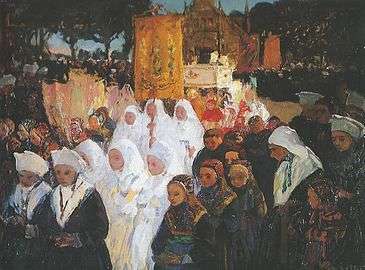 "Jour de Fête-Dieu à Plougastel" by Charles Cottet held in the Musée Crozatier.
"Jour de Fête-Dieu à Plougastel" by Charles Cottet held in the Musée Crozatier. "Femmes de Plougastel au pardon" by Emile Dezaunay.
"Femmes de Plougastel au pardon" by Emile Dezaunay.- Niemeyer's "L'arrivée des fiancés à Plougastel. This is held by the Plougastel-Daoulas Musée de la fraise.
Churches and chapels in Plougastel-Daoulas
The église Saint-Pierre
The parish church was damaged during the bombing of the 22 and 23 August 1944 and subsequently rebuilt. It contains a notable "rosary" altarpiece and a "mise au Tombeau" both from the old church.[2]
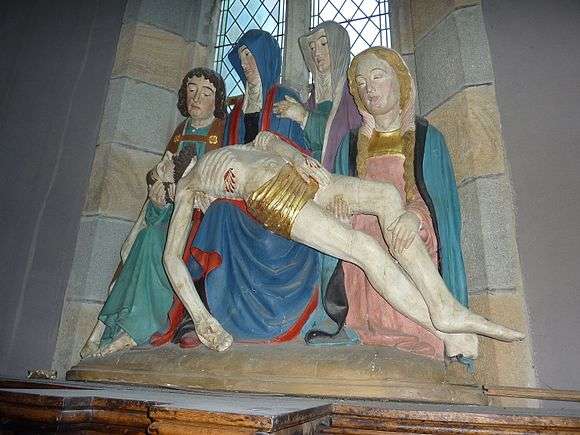
The Chapelle Saint-Adrien
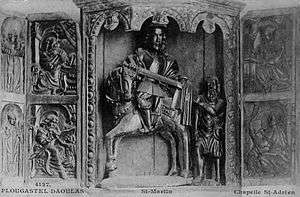
This chapel has an interesting 17th-century sculpture in wood entitled "Saint Martin et le Pauvre". It depicts Saint Martin's charitable works. See old postcard above showing the sculpture.[3][4] The chapelle Saint-Adrien dates to 1549 according to the inscription over the south porch.
. The chapel contains many statues of saints.[2]
The Chapelle Saint-Jean
Dating to the 15th-century, enlarged in 1607 and restored in 1780. This chapel is associated with a pardon known as the "Pardon des Oiseaux".
The Chapelle Saint-Guénolé
Dedicated to the founder of the abbey at Landévennec, the chapel was restored in 1896. A beam in the chapel bears the date 1514 and by the chevet window there is a stone inscribed "M. I. Le Galle. Cariou. v. 1706". The altarpiece dates to the 17th-century and was restored in 1993. There is a statue in polychromed wood of Saint Guénolé in the chapel to the left side of the altarpiece.[2] There are two triptychs in the chapel. One is the Saint Caradec triptych and the other is the Saint Louis triptych.
- The Saint Caradec triptych
- Saint Gouesnou
- Saint Goulven
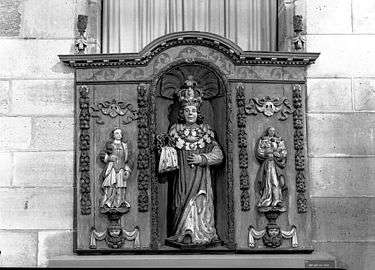 The Saint Louis triptych
The Saint Louis triptych
The Chapelle Notre-Dame-de-la-Fontaine-Blanche
This was once the priory of the abbey of Daoulas. The clock tower dates to 1702. There are three altars in the chapel dedicated to Saint Lawrence, Saint Mary Magdalene and the Virgin Mary ("Notre-Dame"). These were consecrated in 1508 by Jean Davesnes.[2]
The Chapelle Saint-Claude
Dates to the 16th century. The date 1652 is inscribed above the main entrance. A statue of saint-Claude on a throne is placed by the altarpiece by the main altar. Other dates inscribed are "H. et D. Le Maucaire prieur recteur de Plougastel Jan Corre Fabrique 1661" on the west façade, "Jehan Le Gall Fabrique 1661" on the gable of the south wing and in the sacristy "1747". A painting by Yves Hen in the chapel dates to 1661.[2]
- The chevet of the Saint-Claude chapel.
- The Calvary.
- A depiction of the crucifixion in the Saint Claude chapel.
Other calvaries
Of the many calvaries around Plougastel-Daoulas, two involve the sculptor Roland Doré (sculptor).
- The Calvary of Saint-Claude dates to 1630) and has sculptures depicting Saint Peter, Saint Yvese and a Pietà.[2]
- The Calvary at Saint-Guénolé.[2]
See also
- Communes of the Finistère department
- The calvary of Plougastel-Daoulas
- List of the works of the Maître de Plougastel
- List of the works of the Maître de Thégonnec
References
- ↑ (French) Ofis ar Brezhoneg: Enseignement bilingue
- 1 2 3 4 5 6 7 "Saint-Adrien". Retrieved 12 January 2016.
- ↑ "Saint Martin et le Pauvre". Retrieved 12 January 2016.
- ↑ "Chapelle Saint-Adrien". Retrieved 12 January 2016.
External links
| Wikimedia Commons has media related to Plougastel-Daoulas. |
- Official website
- (French) Site sur Plougastel Daoulas
- (French) Musée de la fraise
- (French) La course du pont sur l'Elorn - May, 15 2010
- (English) G.M. Darrow, The Strawberry: History, Breeding and Physiology
- (French) Cultural Heritage
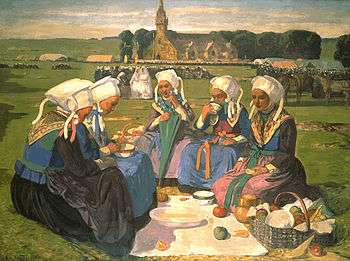
.svg.png)